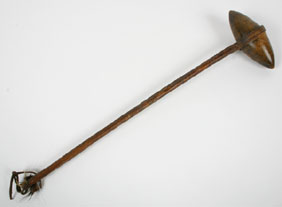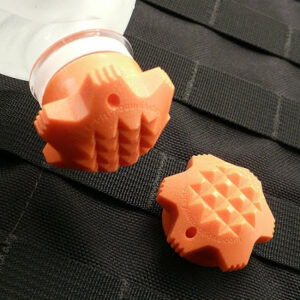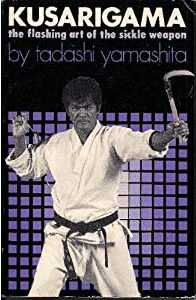Among my various files is a copy of HG Lang’s 1923 book on stick fighting. Not expecting anything particularly original from this I have only recently got around to looking at it, and it was to prove far more interesting than expected. According to the introduction Lang had got at least one Indian police force to adopt the walking cane as a weapon. He claims the cane has more reach and provides a better defence than a truncheon but is handier and faster than a lathi.
Lang does not give us any dimensions for the cane he uses, other than to tell us it is:
"An ordinary Malacca Can(e) or Ash Root Walking stick …The weight of the stick should be such as can be manipulated comfortably by the individual’s wrist. Sacrifice weight to speed always, for remember, that man is an easily vulnerable animal and has many soft spots"
The main method suggested for using the item is to grip it about six inches above the butt and strike with the head. To achieve this hold requires as change of grip from how a walking cane is usually held but this can easily be achieved. If the head is held in the left hand open the right hand and swing the butt up to meet the right palm. The stick is now held in both hands and can be used to parry, or either end used to thrust and strike. If the left hand is released the head can be used to strike as Lang instructs. If the right hand is released the butt end can be used to strike.

While on the topic of canes I will mention AC Cunningham’s 1913 book. What is interesting is Cunningham’s use of a low guard. In Medieval times the low guard was sometimes called the “Iron Gate” since it protected the lower body so well. It was also called the “Fool’s Guard” since it was deceptive. While the upper body appears vulnerable the weapon is in a good position for many defensive and counter offensive moves. This is a particularly good guard for a walking stick. Firstly, it is easily adopted from how a walking stick will normally be held. Secondly the low position makes it harder for an attacker to grab at the stick.

One of the advantages of the walking cane is that it is readily to hand. If you are attacked there is a good chance that you will not have time to draw a weapon before you have to defend against the first assault. You will only have your natural weapons and whatever is already in your hands to defend yourself. This is why the techniques in my book are important to know even if you wear a handgun all the time.
The Indian police who adopted Lang’s techniques doubtless found that having a stick always in hand ready for instant action was very useful. If older movies are to be believed police would often walk the beat nightstick in hand. The lead character in Joseph Wambaugh’s novel and movie the Blue Knight gets his nickname of “bumper” from a routine he does with his nightstick to amuse children. The FBI Baton manual I posted a link to recently recommends the short grip as suited to discretely keeping the weapon ready when interviewing a member of the public. The original Yawara Manual advises that the yawara stick can be kept in hand for the same reason. Modern cops seem to keep their batons on their belts, however, which must put them at a disadvantage in the first second or so of an unexpected assault.
 On a more practical level, a sword could be worn on the belt or mounted on the saddle and rapidly drawn, making them useful back-up weapons. For many knights the sword was not their first choice of melee weapon, however. Widespread use of armour often required something harder hitting. One such weapon was the war-hammer. Long handled hammers were used for foot combat both on the battlefield and in the tournament. The hammer was also well suited to mounted warfare, with the “horseman’s hammer” constituting a whole sub-class of weapon. Since it concentrates its force a hammer hits harder than a sword but can use a lighter head than an axe or mace. This allows the use of a longer haft, giving the horseman more reach. Many hammers were equipped with a backspike, beak or pick, increasing versatility. A blow with the point could penetrate armour, but did have the risk of the pick becoming stuck. A blow with the hammer poll had less risk of sticking but might still buckle the armour and damage the body beneath, or just knock the enemy from his saddle. Doubtless the pick/ backspike could be used to hook and pull an enemy on occasion.
On a more practical level, a sword could be worn on the belt or mounted on the saddle and rapidly drawn, making them useful back-up weapons. For many knights the sword was not their first choice of melee weapon, however. Widespread use of armour often required something harder hitting. One such weapon was the war-hammer. Long handled hammers were used for foot combat both on the battlefield and in the tournament. The hammer was also well suited to mounted warfare, with the “horseman’s hammer” constituting a whole sub-class of weapon. Since it concentrates its force a hammer hits harder than a sword but can use a lighter head than an axe or mace. This allows the use of a longer haft, giving the horseman more reach. Many hammers were equipped with a backspike, beak or pick, increasing versatility. A blow with the point could penetrate armour, but did have the risk of the pick becoming stuck. A blow with the hammer poll had less risk of sticking but might still buckle the armour and damage the body beneath, or just knock the enemy from his saddle. Doubtless the pick/ backspike could be used to hook and pull an enemy on occasion.







